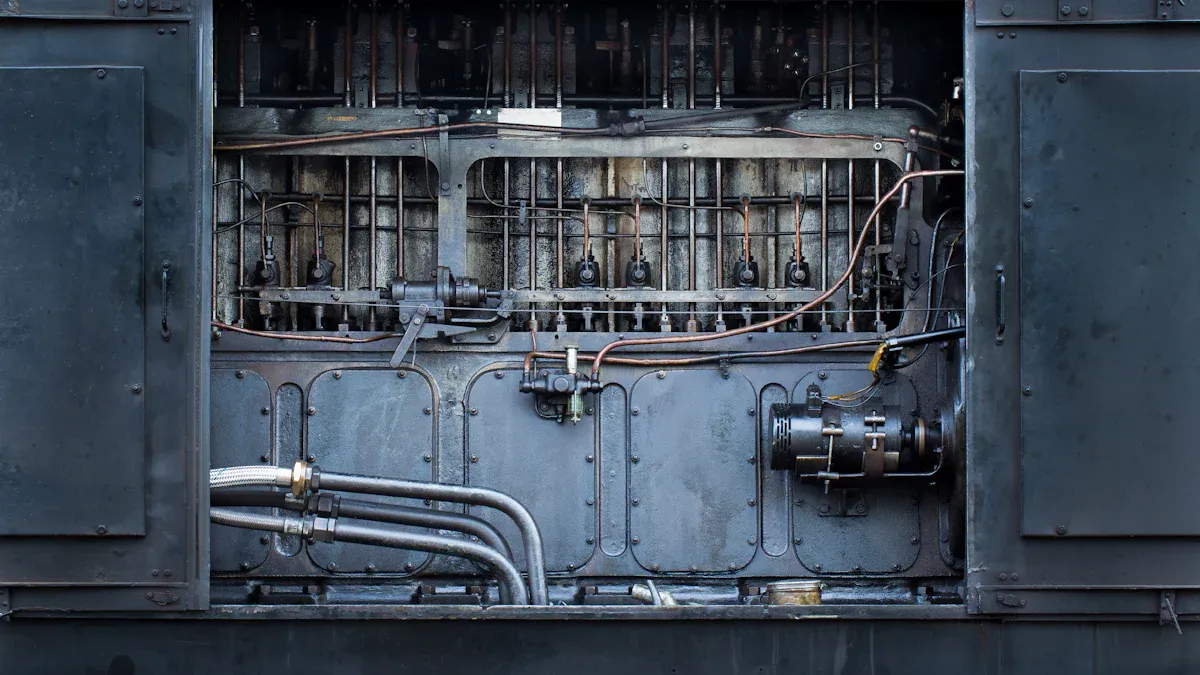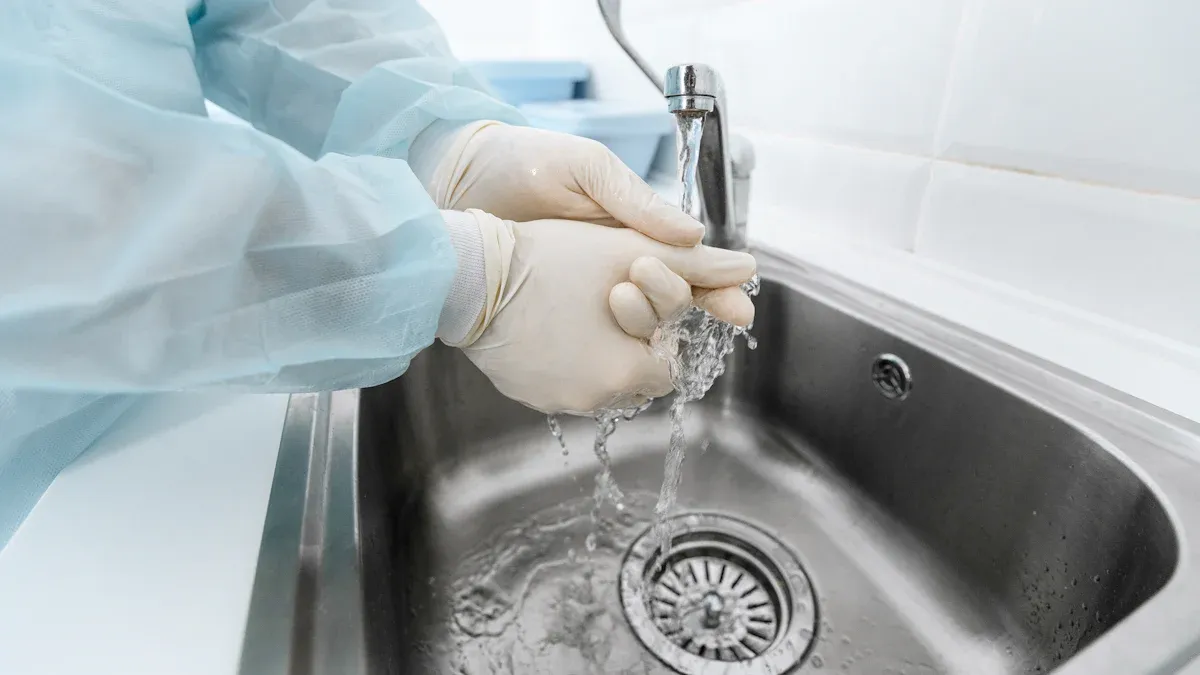Stainless steel is special because it fights rust and damage in three main ways. It has a protective passive layer, strong alloying elements, and special surface features. The passive layer is mostly chromium oxide. This layer covers the steel and blocks water and air. This barrier lowers the chance of rust. It helps the steel stay strong for a long time. Nickel and molybdenum are alloying elements. They make
stainless steel last longer in hard places. Smooth surfaces and easy cleaning help
stainless steel resist damage. These features also help it keep its shine.
Our Company uses these properties to give strong steel solutions.
The passive layer helps stop corrosion.
This layer works like a shield against water and air.
How well it works depends on care and the place it is used.
Key Takeaways
Stainless steel stops rust with a special layer that keeps out water and air.
Cleaning it often with gentle soap and a soft cloth keeps this layer strong and stops rust.
Nickel and molybdenum make stainless steel stronger and help it fight rust, even in tough places.
Picking the right stainless steel grade is very important for each job so it lasts long and works well.
Smooth surfaces help stop rust because water and chemicals cannot hurt the steel as easily.
Chromium & Passive Layer
Stainless Steel & Chromium
Chromium helps stainless steel stop rust. When chromium mixes with steel, it changes how the metal acts. Stainless steel needs at least 10.5% chromium to fight rust. Most types have even more chromium. More chromium helps the steel fight damage from chemicals and air. If chromium drops below 12%, the steel loses its shield. Rust can start, and the metal may not make a strong protective layer.
Stainless steel needs at least 10.5% chromium to be called stainless.
More chromium means better protection from chemicals and air.
The surface does not get a protective layer if chromium is less than 12%.
Chromium under 12–15% can cause rust between grains.
Passive Film Formation
Chromium in stainless steel reacts with oxygen from the air. This makes a thin, clear layer of chromium oxide on top. The passive film works like a shield. It stops water, air, and other bad things from touching the steel. This shield helps stainless steel fight rust. How thick and strong the film is depends on where it is. In places that are not acidic, the film stays strong and protects the steel. In acidic places, the film can get weak, and rust may start.
The passive film can fix itself if it gets scratched, so the steel stays safe.
Limits of Protection
The passive layer on stainless steel works in many places. But some things can break this shield. Chloride ions in salt and seawater can hurt the passive film. This causes small holes and deeper rust. Strong bases and lots of moisture also make the shield weaker. Dirty air can make rust happen faster. When the shield breaks, the steel loses its power to fight rust and damage.
Chloride ions make the shield break down faster.
Lots of moisture, salt, and dirty air are big problems for stainless steel.
Alloying Elements
Nickel’s Role
Nickel helps stainless steel fight rust better. When nickel is added, it makes a strong passive layer. This layer keeps the metal safe from rust and harm. Nickel also helps stop tiny holes from forming. These holes can come from strong chemicals. Even a little nickel, like 3%, helps a lot. Nickel lets stainless steel stay strong in many places. It also slows down how fast the steel rusts. This works when the surface is active or passive. That is why nickel is important in many stainless steels.
Molybdenum Benefits
Molybdenum gives extra help to stainless steel. It is very useful where there is a lot of salt or chlorides. Molybdenum helps keep the passive film from breaking. It also slows down how fast the metal wears away. Over time, molybdenum builds up on the surface. This makes the steel even better at fighting rust. The table below shows what molybdenum does:
Mechanism | Description |
Prevention of Passive Film Breakdown | Molybdenum helps prevent the breakdown of passive oxide films, enhancing resistance to pitting in chloride environments. |
Reduction of Active Metal Dissolution | Molybdenum reduces the dissolution rate of the active metal during localized corrosion, aiding in repassivation. |
Surface Enrichment | Molybdenum shows surface enrichment over time, which contributes to improved corrosion resistance. |
Nickel and molybdenum together make stainless steel last longer. They help it stay strong in hard places.
Corrosion Resistance Grades
Stainless steel comes in different types. Each type fights rust in its own way. The table below compares three common grades:
Stainless Steel Grade | Corrosion Resistance Level | Key Features |
304 | Moderate | Good for general use, less resistant to aggressive acids and chlorides |
316 | High | Better resistance to pitting and crevice corrosion, suitable for marine applications |
316L | Very High | Enhanced corrosion resistance, ideal for aggressive chemical environments |
Other types, like ferritic and martensitic, have special jobs. Ferritic stainless steel is used in car trim and food tools. Martensitic types are good for knives and springs. You should pick the right type for where it will be used. Grades with more alloy may cost more at first. But they last longer and need less fixing in tough places.
Surface Properties
Smooth Surfaces
Smooth surfaces help stainless steel fight rust. When the steel is polished, it gets less rough. This makes it harder for things like water or chemicals to attack. Fewer pits and cracks mean rust has fewer places to start. A smooth finish helps the passive layer form evenly. Stainless steel with a fine finish is easier to clean. It does not trap dirt or chemicals as much.
Smoother finishes lower the chance of pitting corrosion.
Polished surfaces fight crevice corrosion better than rough ones.
Electropolished stainless steel has a better passive film.
A smooth surface helps stainless steel stay shiny. It also helps it last longer in tough places.
Cleaning & Maintenance
Cleaning and taking care of stainless steel keeps the passive layer safe. Regular cleaning removes dirt and harmful stuff. This helps the passive film stay strong. Use mild soap and a soft brush to clean stainless steel. After washing, rinse with clean water. Dry with a soft cloth to stop water spots and stains.
Gently scrub dirt with a nylon brush.
Use mild soap or detergent that is safe for stainless steel.
Rinse with clean water.
Dry with a soft cloth.
Do not use steel wool or harsh chemicals. Touching carbon steel or iron can cause rust. Wearing clean gloves stops fingerprints and marks.
Cleaning often helps stainless steel fight rust. It also helps it last longer, even in hard places.
Physical Damage Resistance
Stainless steel is strong and tough. It can handle heavy loads without bending. It is hard but can bend without breaking. This makes it hard to dent or scratch.
Property | Benefit |
High tensile strength | Handles high pressure and stress |
Ductility | Bends but does not break |
Hardness | Fights surface damage and wear |
These features make stainless steel great for places that need strong and rust-resistant metal. If it gets scratched or dented, you can fix it easily. Buffing or using a soft cloth can make it look new again.
Stainless steel stops rust and damage in three main ways. The passive layer acts like a shield and fixes itself if scratched. Alloying elements such as chromium, nickel, and molybdenum make it stronger against rust. Smooth surfaces and cleaning help the steel stay shiny and tough. The table below shows how each way works:
Mechanism | Effectiveness Against Rust and Damage |
Passive Layer | Makes a shield that blocks rust, while carbon steel rusts fast. |
Self-Repair Mechanism | The shield forms again if it gets hurt, as long as chromium is there. |
Environmental Factors | Things like salt, acids, and heat can make rust happen faster. |
Picking the right stainless steel grade is important for each place. Grades that fight rust well are best for areas with chemicals, water, or salt. Food factories need stainless steel that does not react with food. Chemical plants need grades that can handle tough conditions. If you pick the wrong grade, you might get pitting, crevice, or stress corrosion.
Stainless steel rusts much less than other metals, even when it is hot.
Stainless steel lasts a long time and needs little care. It is also good for the planet. The table below lists these good points:
Benefit | Description |
Extended durability | Stainless steel buildings last about twice as long as carbon steel ones. |
Lower maintenance requirements | You do not need to fix it much, so it is good for busy places. |
Optimized weight | It is strong, so you can use less metal and make things lighter by up to 30 percent. |
Sustainability | Stainless steel can be recycled and helps keep the earth clean. |
Rules help people pick the right stainless steel grade for each job. This makes sure the steel works well and lasts a long time. Stainless steel is special because it fights rust, is strong, and lasts many years.
FAQ
What makes stainless steel different from regular steel?
Stainless steel contains chromium and other elements. These create a protective layer that blocks rust. Regular steel does not have this shield, so it rusts faster.
Can stainless steel rust in salty or wet places?
Yes, stainless steel can rust in salty or wet places. Chlorides in saltwater can break the protective layer. Choosing the right grade helps prevent this problem.
How should people clean stainless steel to prevent rust?
People should use mild soap, water, and a soft cloth. They should avoid steel wool and harsh cleaners. Regular cleaning keeps the protective layer strong.
Why do some stainless steel grades cost more?
Grades with more nickel or molybdenum cost more. These elements make the steel stronger against rust and damage. Higher grades last longer in tough places.
Does stainless steel need special care after scratches?
Yes. Scratches can weaken the protective layer. Cleaning and polishing help the layer repair itself. This keeps the steel strong and shiny.








